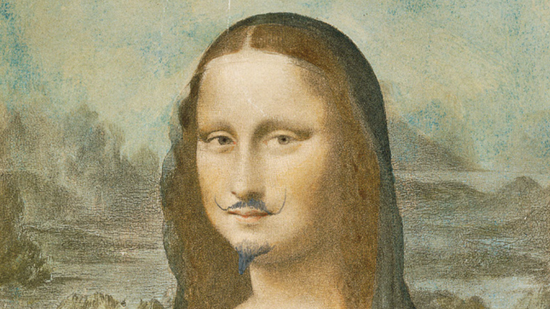
Dadaism was an art movement formed during World War I in Zurich as a reaction to the horrors and madness of war. The art, poetry and performance produced by dada artists is often satirical and nonsensical in nature. Dadaist artists felt that war challenged all aspects of a society. Thus, the artists aimed with these new art pieces to destroy the traditional values of art and create a new art to replace the old one. As artist Hans Arp later wrote:
“Revolted by the carnage of the 1914 World War, we in Zurich devoted ourselves to the arts. As guns rumbled in the distance, we sang, painted, made collages and wrote poems with all our might.”

In addition to being anti-war, dada was also anti-bourgeois and had political affinities with the radical left. The founder of dada was the writer, Hugo Ball. In 1916, he founded the magazine that took the name of 'Dada'. Dada, Dada, Dada, Dada', being the first of many Dada publications. This movement turned out to have international proportions and formed the basis of surrealism in Paris after the war. For Dadaist artists, the aesthetics of the work were considered secondary to the ideas they conveyed. “For us, art is not an end in itself,” wrote Dadaist poet Hugo Ball, “but is an opportunity for true insight and criticism of the times in which we live.” Dadaists embraced and critiqued modernity, imbuing their work with references to the technologies, newspapers, films and advertisements that increasingly defined contemporary life.

Dadaist artists innovated with collage and photomontage, using unorthodox materials and procedures based on chance, exploring games, experimental theater and performance. It was artists like Hans Arp who incorporated chance into the creation of works of art, something that went against all the norms of traditional artistic production, where a work was meticulously planned and completed. The introduction of chance was a way for the Dadaists to challenge artistic norms and question the role of the artist in the artistic process.
“Hans Arp made a series of collages based on chance where he stood above a sheet of paper, dropping squares of contrasting colored paper onto the surface of the larger sheet and then gluing the squares wherever they landed on the page. The resulting arrangement might then elicit a more visceral reaction, like the guessing of the I-Ching coins that Arp was interested in, and perhaps provide a further creative stimulus. Apparently, this technique came about when Arp became frustrated with attempts to compose more formal geometric arrangements. Arp's random collages came to represent Dada's aim to be "anti-art" and his interest in accident as a way to challenge traditional techniques of artistic production.
Major artists associated with the Dadaist movement include Arp, Marcel Duchamp, Francis Picabia and Kurt Schwitters. One of the leading artists, Marcel Duchamp, declared that ordinary manufactured objects are works of art when modified by the artist: “readymade”. This radically challenged the notion of a Western work of art subsequently having a profound influence.

In fact, Dadaism was the direct antecedent of the Conceptual Art movement, where artists' focus was not on creating aesthetically pleasing objects, but on creating works that often subverted bourgeois sensibilities and questioned our role in society, the role of the artist and the purpose of art. After the dissolution of the various Dadaist groups, many of the artists joined other artistic movements - in particular Surrealism. Indeed, the Dadaist tradition of irrationality and chance led directly to the Surrealist for fantasy and the expression of the imaginary, with several artists being members of both groups, including Picabia, Arp and Ernst. Almost all of the underlying postmodern theories in Art, such as performance, the overlap of art with everyday life, the use of popular culture, audience participation, interest in non-Western art forms, the embrace of the absurd and the use of chance were influenced by Dadaism. Furthermore, this movement also had a profound influence on graphic design and the field of advertising with the use of collage.

